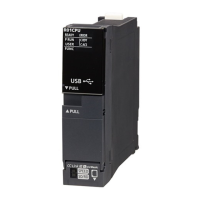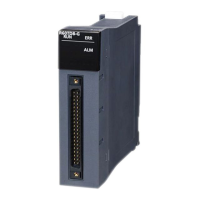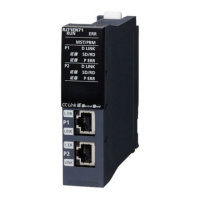238
13 DATABASE FUNCTION
13.2 Database Access Instruction
Specifications of the character code for Unicode text files are as follows:
• Character encoding schema: UTF-16 (Little-Endian)
•BOM: Yes
■Format of setting values in Unicode text
*1 "E" can be specified in lower case.
*2 The exponent part must always have a sign.
Configuration of Unicode text files
[Tab] in the figure represents a tab character and it is entered using the key on the keyboard in practice. Line breaks,
comments, tabs, and spaces are processed as follows.
Item Description
WORD, DWORD,
INT, DINT
The value must be specified in the decimal format (e.g. 0, 1, 111, -111).
BOOL The value must be 0 or 1.
REAL, LREAL The value must be specified in the following exponential format (e.g. 1.0e-01, 1.0E+01):
Mantissa + E
*1
+ Exponent part
*2
Item Description
Line break • The line break code is CR+LF.
• Lines consisting of only line breaks are ignored.
Comment A row beginning with "//" is regarded as a comment.
The maximum number of characters in a comment row is 2048 (including two characters for the line break code).
Tab Tabs cannot be used for database names, table names, field names, key constrains, and setting values. Tabs are recognized as
delimiters.
Space • Spaces between tabs and printable characters are not recognized as a part of settings.
• Spaces between printable characters are recognized as spaces.
Database name
<table>
Table name 1
Field name 1 [Tab] Field name 2 [Tab] ... [Tab] Field name n
Data type 1 [Tab] Data type 2 [Tab] ... [Tab] Data type n
Key restriction 1 [Tab] Key restriction 2 [Tab] ... [Tab] Key restriction n
Index 1 [Tab] Index 2 [Tab] ... [Tab] Index n
Set value 1 [Tab] Set value 2 [Tab] ... [Tab] Set value n
Set value k [Tab] Set value 2 [Tab] ... [Tab] Set value n
</table>
<table>
Table name 2
(The subsequent setting is the same as the setting of Table name 1.)
</table>

